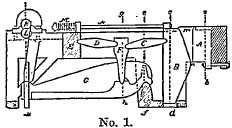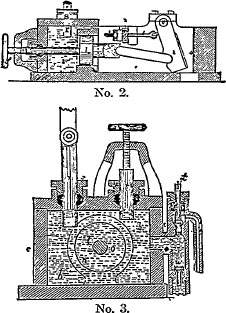
601
Case No. 1,500.
BLAKE v. ROBERTSON et al.
[6 Fish. Pat. Cas. 509; 11 Blatchf. 237.]1
Circuit Court, E. D. New York.
July 2, 1873.
PATENTS—INFRINGEMENT—MECHANICAL EQUIVALENTS—IMPROVEMENT—PRIOR DECISIONS—INJUNCTION—STONE-CRUDSHER.
1. Blake having patented in his patent of June 15, 1838, reissued January 9, 1866, a “machine for breaking stones,” which machine has two upright converging jaws—one fixed and the other moved forward by an iron connecting-rod—between which jaw the stone is broken by the approach of the movable jaw to a specified distance, the patent is infringed by the stone-crusher patented by Austin H. Smith, November 7, 1871, in which the movable jaw is moved forward by a column of confined water, to which pressure is applied by a plunger.
2. In such a combination, the column of compressed water is the mechanical equivalent of the iron connecting-rod.
3. The provision in the Smith machine for the escape of the water, so as to prevent breakage when the stone to be crushed is harder than the iron used to crush it, may be a patentable improvement, but still the machine infringes the patent granted Blake.
4. Though the validity of the patent has been sustained by repeated adjudications, and the infringement by defendants seems clear, yet, as complainant's rights in the present case will be as well protected by a bond, the defendants are required to file an account once in three months of all machines made and sold, and give bond to complainant to pay him such sum as may ultimately be found due him.
[In equity. Bill by Eli W. Blake against John Robertson and others for infringement of letters patent.] Heard on motion for preliminary injunction, which was denied.]
Motion for provisional injunction. Suit brought on reissued letters patent granted Eli W. Blake, January 9, 1866, for “improvement in machinery for crushing stones,” as a reissue of the patent originally granted him, June 15,1838. The patent had been extended after, a vigorous opposition, and had been sustained by several adjudications in the courts. See Blake v. Stafford [Case No. 1,504]; Blake v. Eagle Works Manuf'g Co. [Id. 1,484;] and Blake v. Rawson [Id. 1,499]. The Blake machine, as patented, is shown in the following engraving:

The claims of the patent are stated in the opinion of the court.
The defendants were manufacturing and selling stone-crushers, as patented by Austin H. Smith, November 7, 1871, in which there were the fixed and movable jaws, but the movable jaw was impelled by means of pressure applied to a column of water. The following engravings show the Smith machines

Charles F. Blake, for complainant
Benjamin E. Valentine, for defendants.
HUNT, Circuit Justice. The claims of the patentee are founded upon combinations only. He asks no protection for the discovery of original principles or inventions. The validity of his patent has been adjudicated in several suits brought against alleged infringers other than, the defendants. Blake v. Stafford [Case No. 1,504]; Blake v. Eagle Works Manuf'g Co. [Id. 1,494]. It is admitted by the defendants' counsel, that it is to be taken to be a valid patent, for the purposes of this motion. The only question is, whether the defendants have infringed upon it.
The claims in the specification of the patent are as follows: “1. The combination, in a stone-breaking machine, of the upright convergent jaws, with a revolving shaft and
602
mechanism for imparting a definite reciprocating movement to one of the jaws from the revolving shaft, the whole being and operating substantially as set forth; 2. The combination, in a stone-breaking machine, of the upright movable jaw with the revolving shaft and fly-wheel, the whole being and operating substantially as set forth; 3. In combination with the upright converging jaws and revolving shaft, imparting a definitely limited vibration to the movable jaw, so arranging the jaws that they can be set at different distances from each other at the bottom, so as to produce fragments of any desired size.”
The answer to the alleged violation is based, first, upon the allegation, that the defendants use no fly-wheel. This is a question of fact, upon which the affidavits differ, the balance being with the complainant. The second and more important defence is, that the Smith machines, manufactured and sold by the defendants, do not create, or impart to the movable jaw, a definitely limited motion, while this result is admitted to be the effect and the intent of the Blake machine.
The modus operandi of the Blake machine is this, so far as it is necessary to specify it The one jaw of the machine is fixed, the other movable, and, by the approach of the latter to a specified distance, the stone is crushed to the required size. The precise distance of this approach is regulated at pleasure. The motion is produced by a revolving shaft, an iron connecting rod and a crank, a return motion being secured by spiral springs. The revolution of the crank gives a short and definitely limited vibration to the movable jaw. The vibration is limited in its extent, but the distance indicated must necessarily be passed over by the movable jaw. It is alleged, that, whereas, in the Blake machine, this motion is accomplished by means of an iron rod, having no power to stop short of the distance limited, whatever may be the result to the machine itself, this bad consequence is obviated, in the Smith machine, by the use of water as the motive power. In the latter machine, instead of applying the force to the movable jaw by an iron rod, the effect is produced by water. A plunger is forced into a strong vessel filled with water, the water is forced through a passage against the movable jaw, and the motion is thus communicated to it. Connected with this is a safety valve, which opens, in the event of an excess of pressure, and allows the water to pass into another reservoir. In my view, the principle of the two machines is the same, and the operation is the same, speaking in general terms. This principle and this operation is to move the loose jaw by the mechanical force described; and with a given power, to within the specified distance of the fixed jaw, thus breaking the stones into the required size. Whether the force is applied by hand power, water power, or steam power, in principle, is unimportant. Whether the force is applied to the jaw by its contact with a wooden beam, with an iron rod, or with a column of water, is unimportant, in principle. These are mechanical equivalents, and a patentee cannot be deprived of the benefit of his invention by the substitution of one in the place of another. In the Smith machine, the column of confined water produces the same result as the iron rod in the Blake machine. There is no evidence before me, that a column of compressed water is not as powerful as an iron rod. I have no reason to suppose that it is not so.
I am not called upon to determine whether the Smith machine does not possess an advantage over the Blake machine, in that a mode of escape is provided, when the stone to be crushed is harder than the iron used to crush it, and thus a breakage of the latter is avoided. This may be an improvement, for which a patent could be obtained. It does not, however, affect the proposition, that, up to this point, the machines are the same. I think they are the same, and that the defendants are infringing the patent of the complainant.
The machines in question are expensive and bulky, and cannot, in their nature, be the subjects of extensive sale or manufacture. The complainant's rights will be as well protected by an order requiring the defendants to render an account, once in every three months, of the machines manufactured or sold by them, and to give security to the complainant to pay him any sums that may ultimately be found due to him for the causes in the bill of complaint stated, as by an injunction. Let an order to that effect be entered.
[NOTE. Patent No. 20,542 was granted to E. W. Blake June 15. 1858, was reissued (No. 2,145) January 9, 1866, and has been the subject of litigation in the following cases: Blake v. Stafford, Case No. 1,504; Blake v. Eagle Works Manuf'g Co., Id. 1,494; Blake v. Rawson, Id. 1,499; Blake v. Robertson, Id. 1,501; Blake v. Greenwood Cemetery, Id. 1,497; Blake v. Boisselier, Id. 1,493a; and Blake v. Robertson, 94 U. S. 728.]
1 [Reported by Hon. Samuel Blatchford, District Judge, and by Samuel S. Fisher, Esq., and here compiled and reprinted by permission. The syllabus and statement are from 6 Fish, rat. Cas. 509, and the opinion from 11 Blatchf. 237.]
This volume of American Law was transcribed for use on the Internet
through a contribution from Google. 